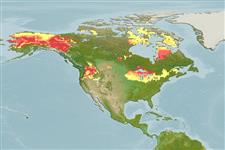Classification / Names
Common names | Synonyms | Catalog of Fishes (gen., sp.) | ITIS | CoL | WoRMS | Cloffa
Actinopterygii (ray-finned fishes) >
Salmoniformes (Salmons) >
Salmonidae (Salmonids) > Coregoninae
Etymology: Prosopium: Greek, prosopon = face (Ref. 45335); cylindraceum: cylindraceum meaning like a cylinder (Ref. 1998).
Environment / Climate / Range
Ecology
Freshwater; brackish; demersal; potamodromous (Ref. 51243); depth range ? - 72 m (Ref. 1998), usually ? - 37 m (Ref. 1998). Temperate, preferred ?; 71°N - 43°N
North America: Arctic and Pacific drainages from western Hudson Bay in Canada to Alaska and northern British Columbia, Canada; Arctic and Atlantic drainages from Labrador in Canada to Connecticut, USA and west through St. Lawrence-Great Lakes basin in Canada-USA (except Lake Erie). Northern Asia: widely distributed in Siberian rivers (Ref. 26334).
Length at first maturity / Size / Weight / Age
Maturity: Lm 30.0 range ? - ? cm
Max length : 59.0 cm TL male/unsexed; (Ref. 40637); common length : 28.6 cm TL male/unsexed; (Ref. 12193); max. published weight: 2.7 kg (Ref. 4699); max. reported age: 16 years (Ref. 28860)
Dorsal
spines
(total): 0;
Dorsal
soft rays
(total): 11-15;
Anal
spines: 0;
Anal
soft rays: 10 - 13. Body slender, elongate, almost cylindrical in cross section, posteriorly somewhat compressed laterally, greatest depth in front of the dorsal fin. Head relatively short; eye moderate, its diameter less than snout length; snout pointed, "pinched" or compressed laterally, rounded in lateral view, a single flap of skin present between the nostrils; mouth small, ventral in position, overhung by snout; maxillaries extending posteriorly almost to anterior margin or eye in adults. This species has more color than most coregonids. Overall coloration of adults almost silvery, silvery white below. Scales specially on back, with well-defined, dark pigmented borders, making them conspicuous. Pectoral fins are amber in color, slight amber tint also to pelvic and anal fins. Pectoral fins take on an orange tint during spawning, the pelvic and anal fins also to a lesser extent. the adipose fin is usually brown spotted, particularly in specimens from central and eastern Canada. Two or more longitudinal rows of black spots are present on the sides of young specimen.
Inhabits shallow areas of lakes and clear streams, rarely entering brackish water (Ref. 5723). Also in rivers with swift current and stony bottom. Migration is limited to movements associated with spawning (Ref. 27547). Epipelagic (Ref. 58426). Feeds on benthic invertebrates and occasionally on fishes (Ref. 1998) and fish eggs (Ref. 593). One specimen taken from a depth of 218.9 m in eastern Lake Superior, off Grand Marais, Michigan (Ref. 1998).
There are inshore and upstream movements (Ref. 28863) that may be related to spawning (Ref. 27547). Swims in pairs during spawning (Ref. 28858). Also Ref. 28803.
Page, L.M. and B.M. Burr, 1991. A field guide to freshwater fishes of North America north of Mexico. Houghton Mifflin Company, Boston. 432 p. (Ref. 5723)
IUCN Red List Status (Ref. 115185)
CITES (Ref. 94142)
Not Evaluated
Threat to humans
Harmless
Human uses
Fisheries: minor commercial; gamefish: yes
More information
ReferencesAquacultureAquaculture profileStrainsGeneticsAllele frequenciesHeritabilityDiseasesProcessingMass conversion
Tools
Special reports
Download XML
Internet sources
